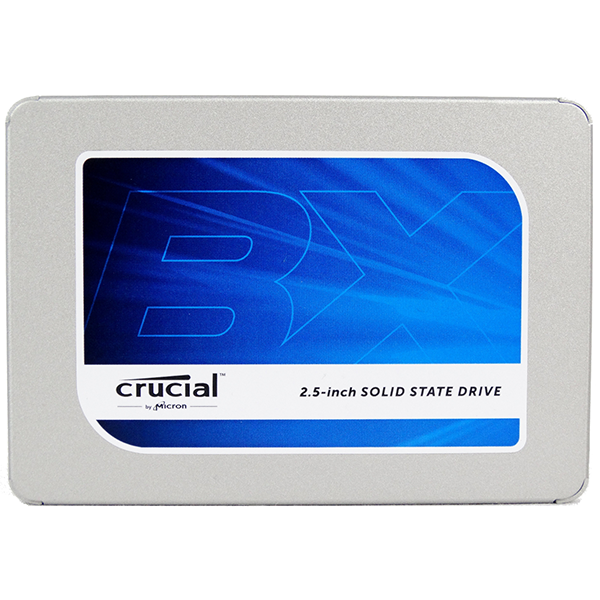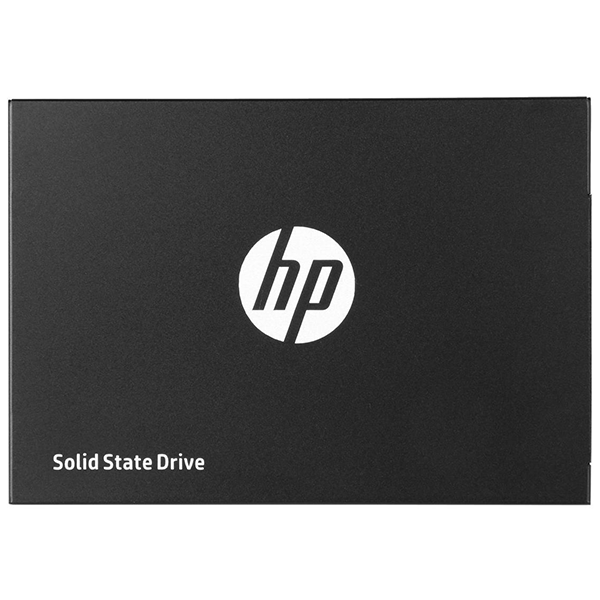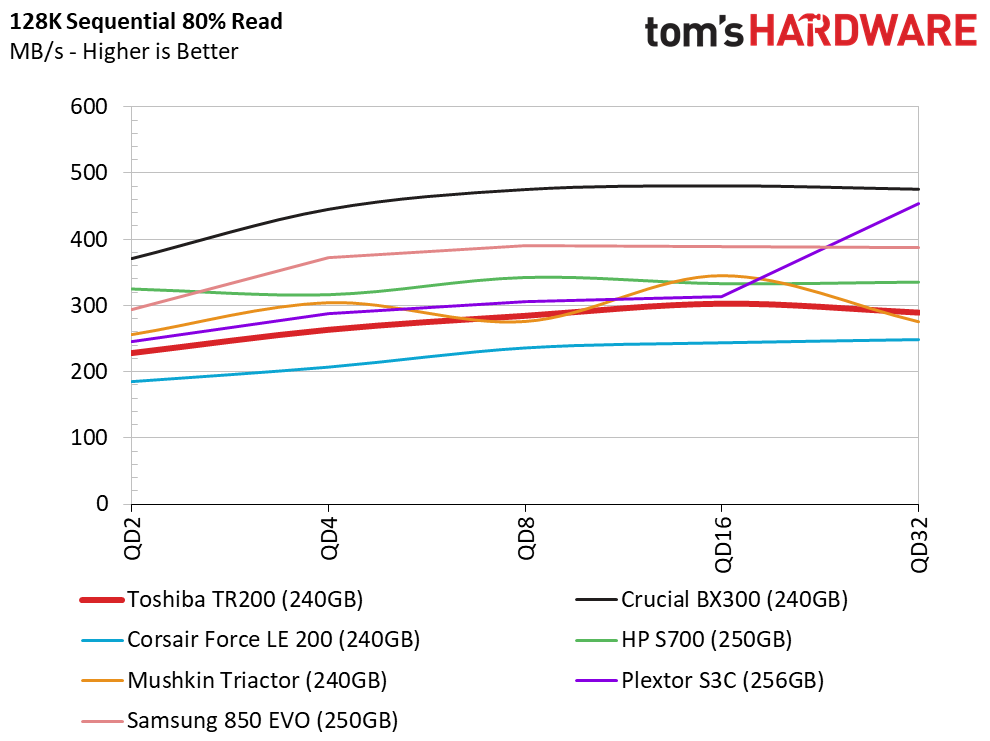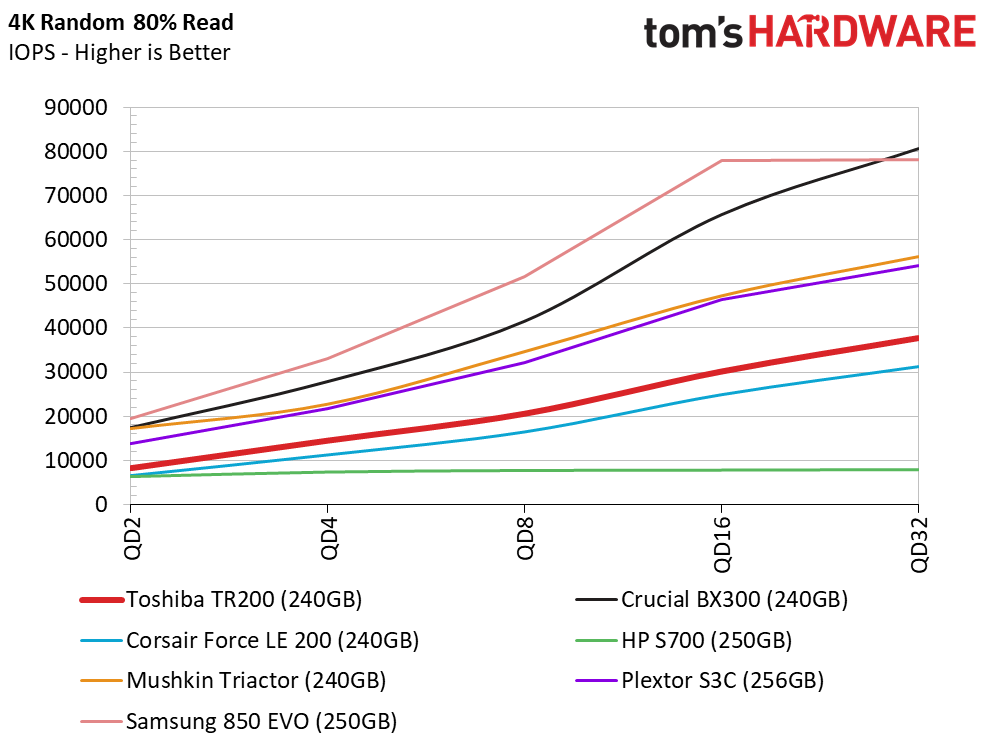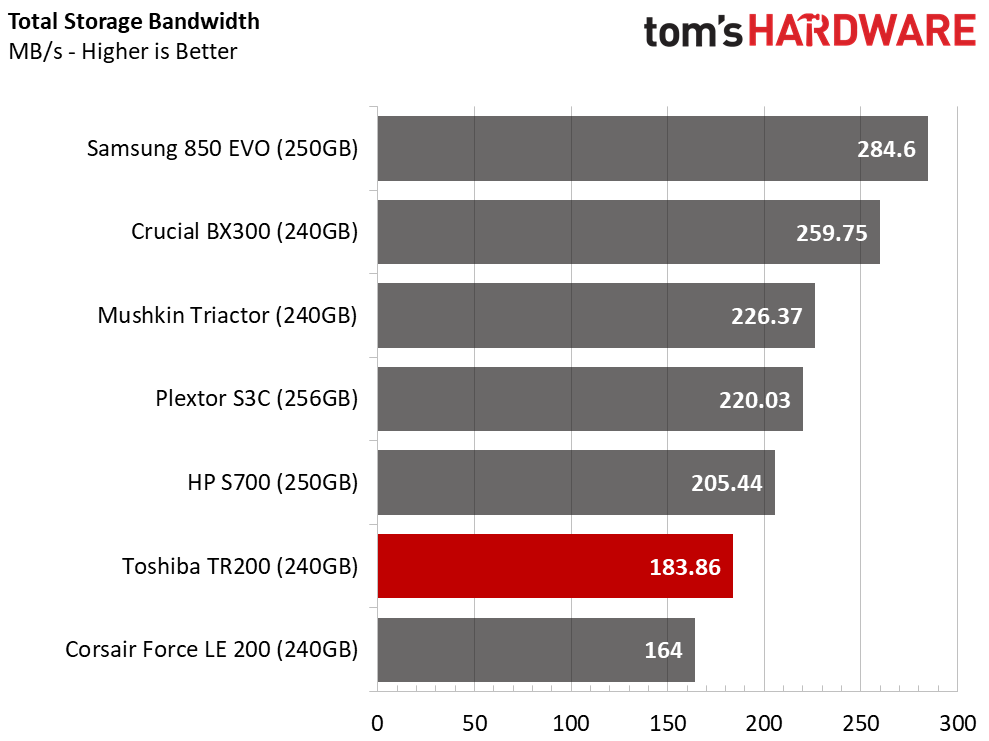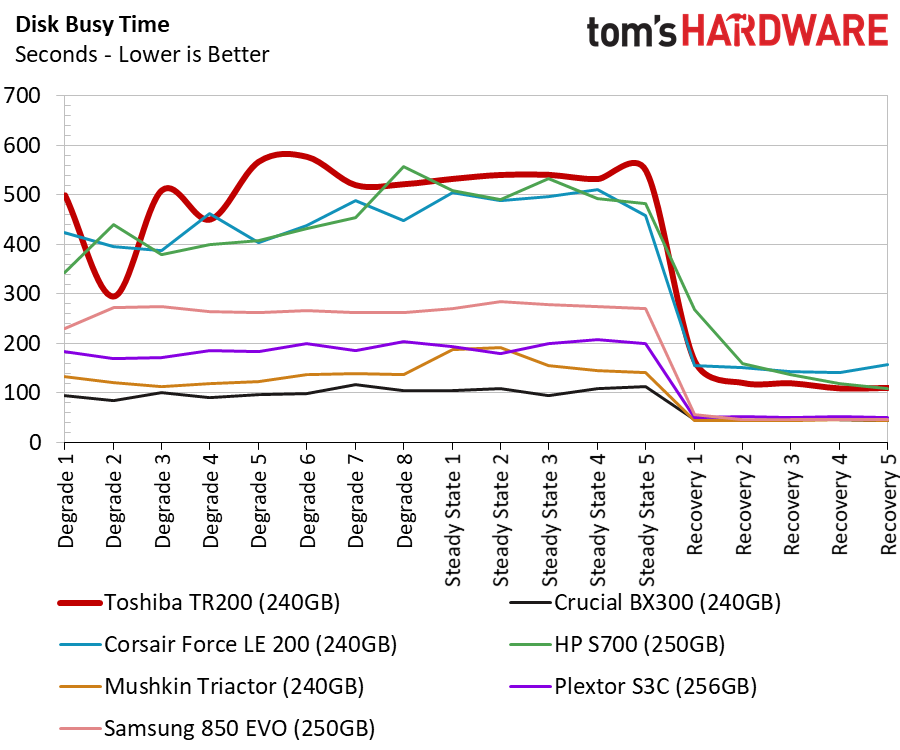Toshiba TR200 SSD Review
Why you can trust Tom's Hardware
256GB SSD Performance
Comparison Products
Entry-level SSDs generally target low price points, and lower capacity products cost less than larger ones. That makes the TR200 240GB analysis slightly more important for shoppers looking to add a low-cost SSD to a basic system. After all, that was the purpose of DRAMless SSDs when they were first launched.
The TR200 240GB has a pricing problem compared to Samsung's mainstream 850 EVO 250GB SSD. The TR200 will come to market priced just $10 less than the industry standard EVO. At one point it was reported that Samsung discontinued the 250GB capacity model, but Newegg, Amazon and other sources still have the drive in stock.
The 850 EVO 250GB is part of the comparison product list along with a few more DRAMless products. The Corsair Force 200 LE and HP S700 are both DRAMless models. They are joined by the Crucial BX300, Mushkin Triactor, and Plextor S3C. All the comparison products fall into the entry-level category, with the 850 EVO being the sole exception. The EVO sells at a similar price point to the other products, and that makes it a crossover product. Its pricing gives other manufacturers headaches, but it makes shopping for an SSD easy.
Sequential Read Performance
To read about our storage tests in-depth, please check out How We Test HDDs And SSDs. We cover four-corner testing on page six of our How We Test guide.
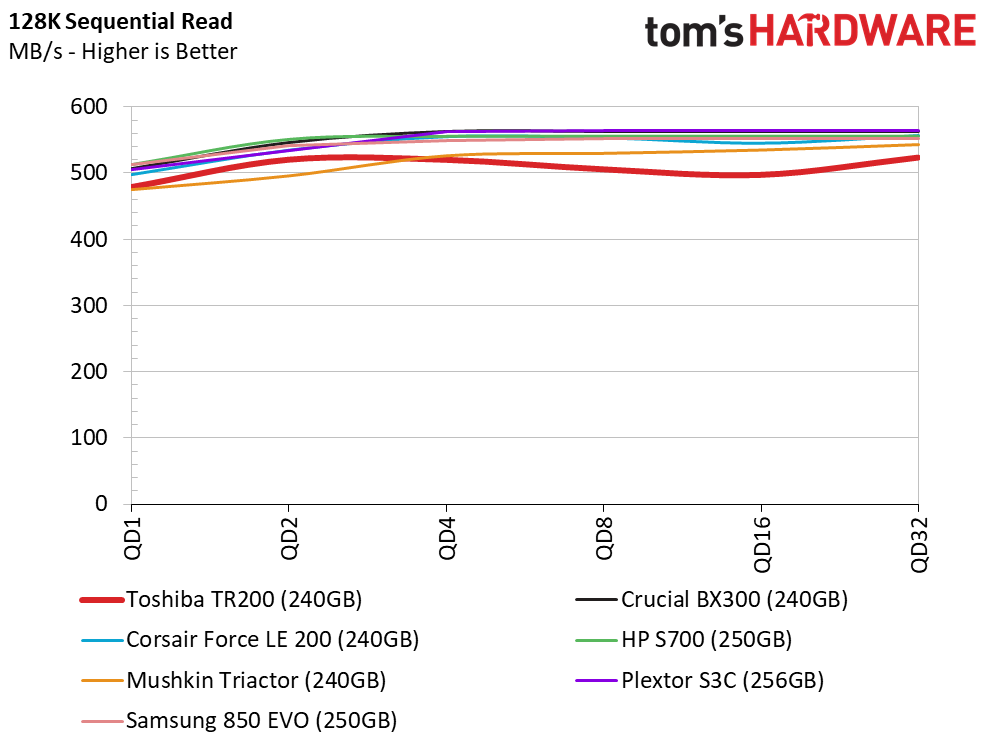
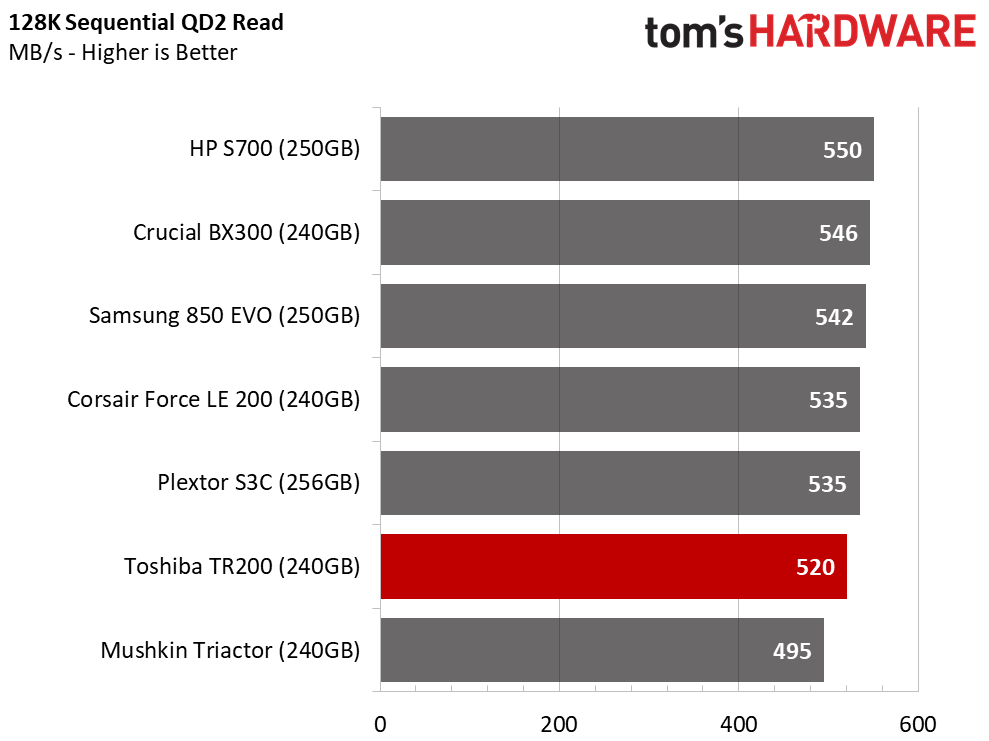
The third and final TR200 shows nearly identical sequential read performance to the other capacities in the same product family. We expect this model to be better in relation to the other products, but we need to look at other areas of performance to see how it fares.
Sequential Write Performance
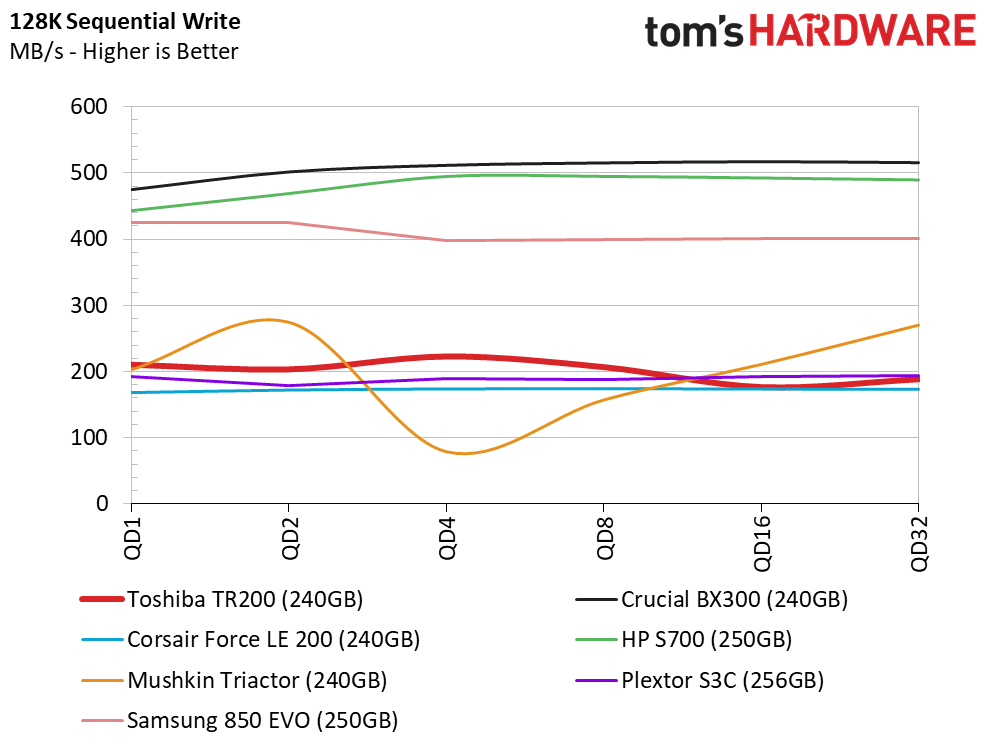
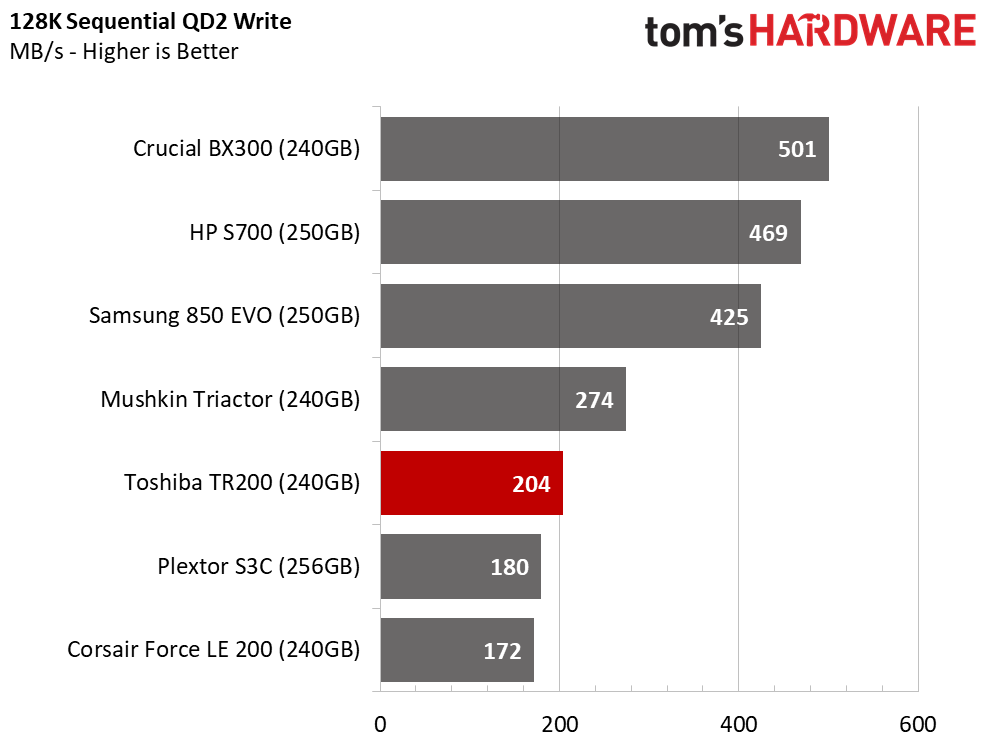
As we expected, the TR200 240GB is the most competitive model in the line up when we compare it to similar products. The performance is about the same across the TR200 product line, but many of the other products lose performance as capacity decreases.
Random Read Performance
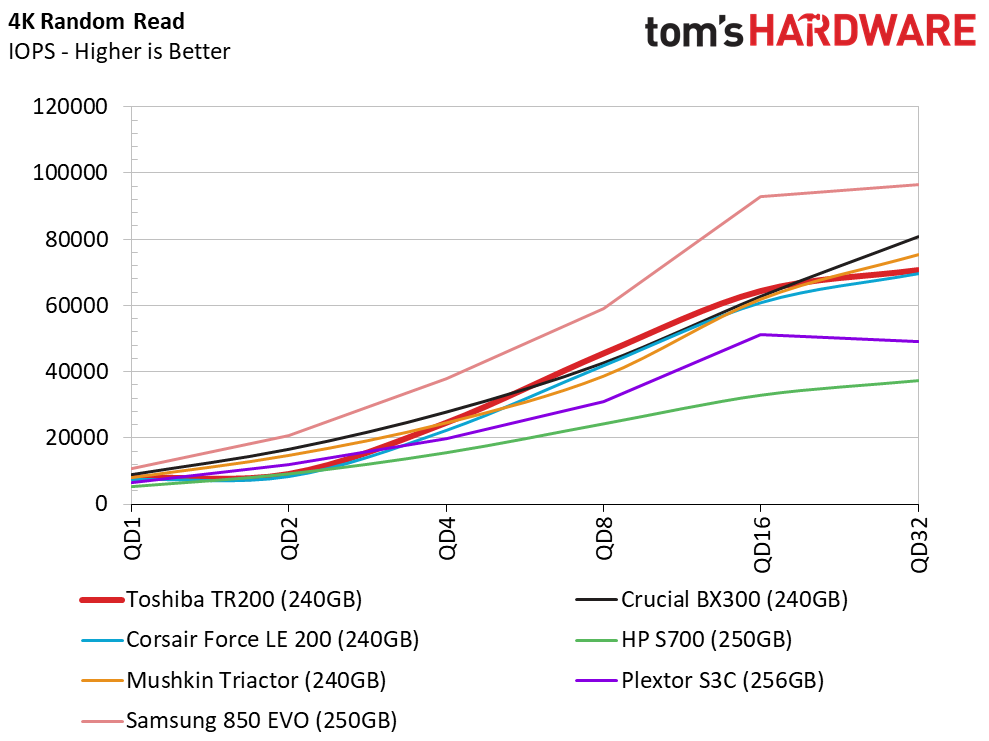
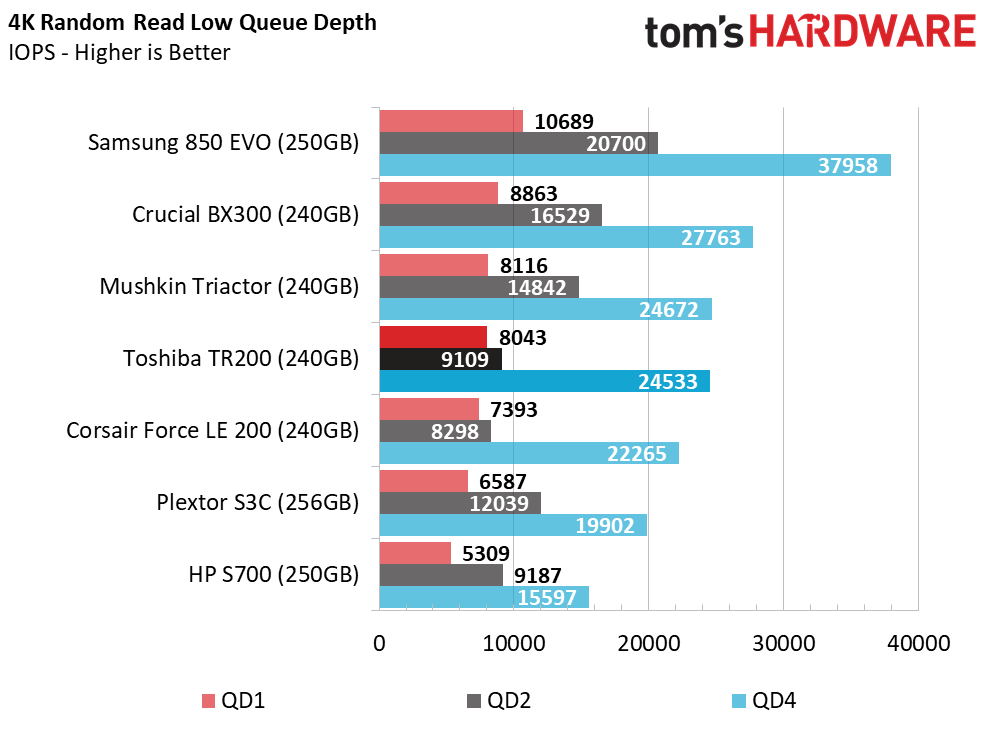
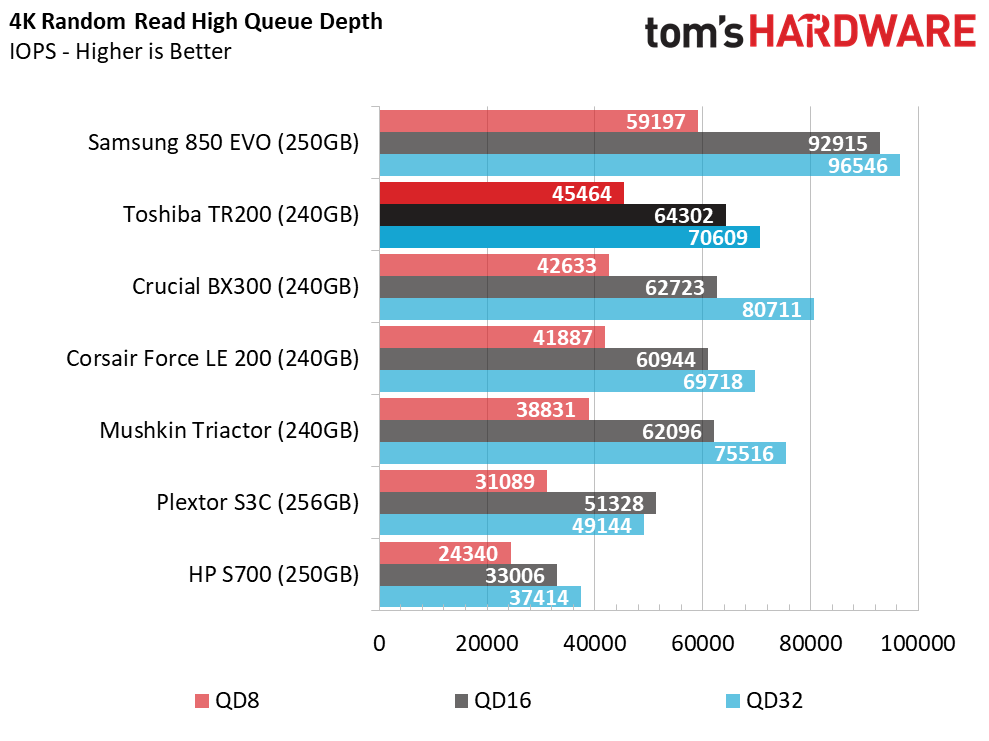
The TR200 240GB slots in the middle of the entry-level products in random read performance. It outpaces the other DRAMless SSDs in nearly all queue depths.
Get Tom's Hardware's best news and in-depth reviews, straight to your inbox.
Random Write Performance
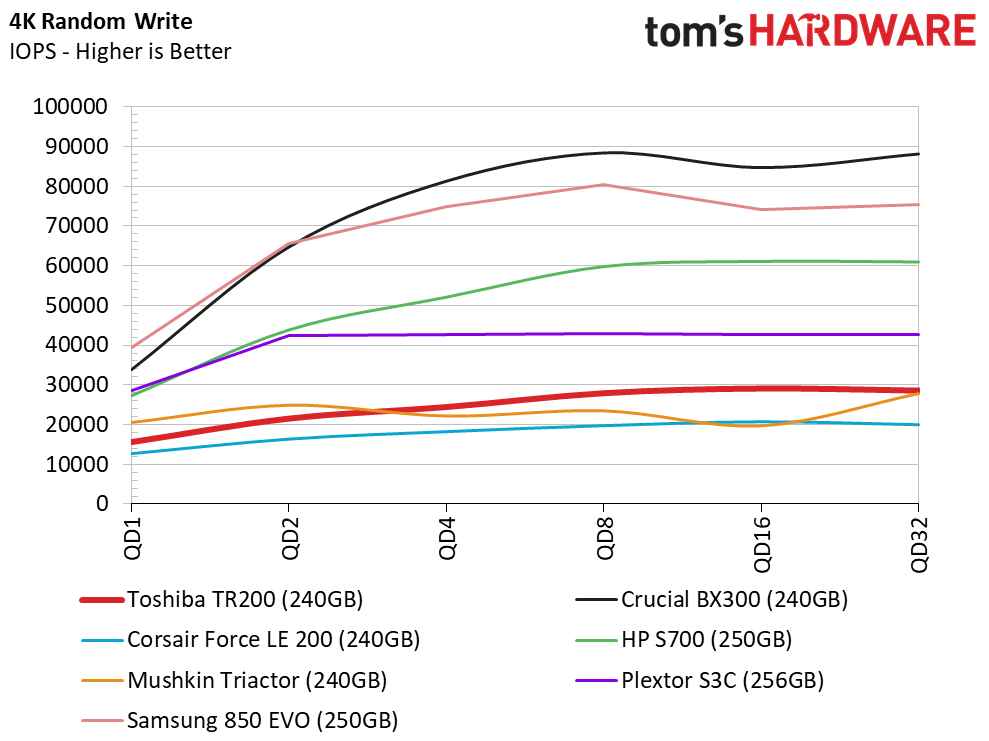
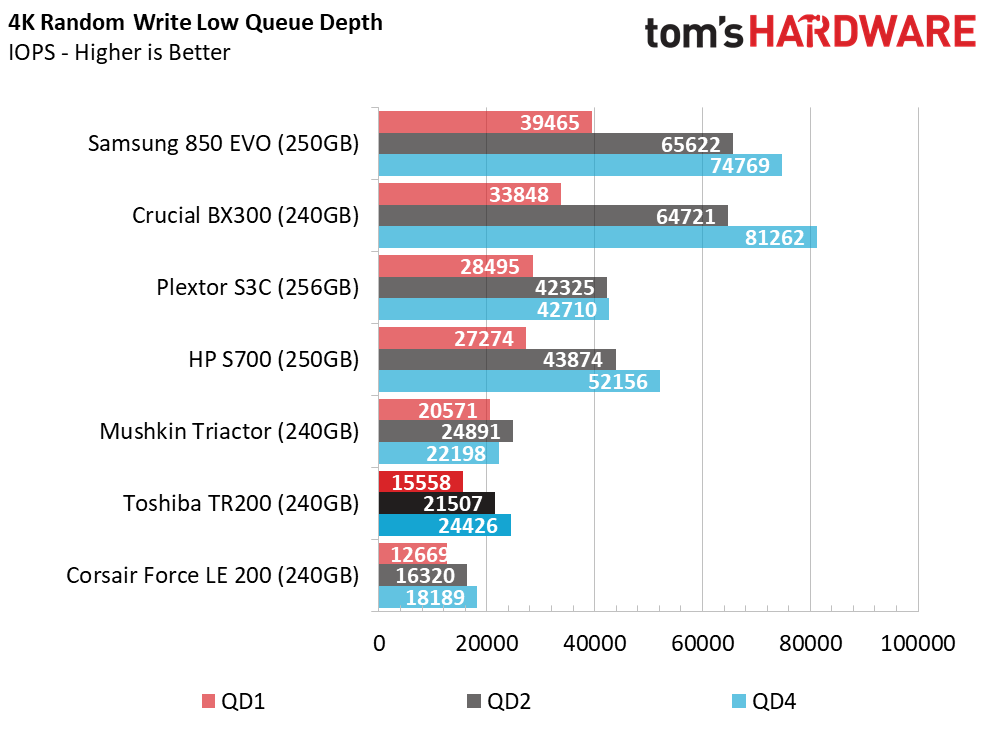
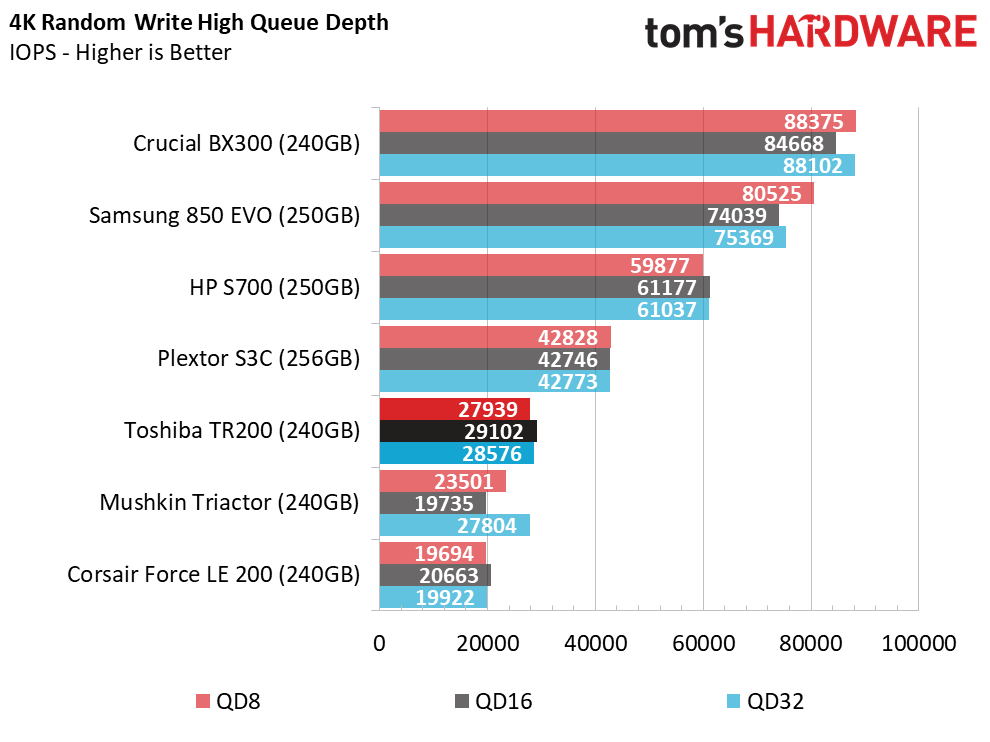
We have to lump all of the DRAMless SSDs into a separate category because they have a performance weak spot with small-block random writes. We hoped the new BiCS FLASH would solve some of these issues, but the TR200 has a difficult time keeping pace with the HP S700, which features an SMI SM2258XT controller paired with Micron's first generation 3D TLC. We know BiCS is better than what we see in these charts today, but the controller and architecture hold the flash back from unleashing its full potential.
80% Mixed Sequential Workload
We describe our mixed workload testing in detail here and describe our steady state tests here.
The Corsair Force LE 200 uses the Phison S11 DRAMless controller that is very similar to the Toshiba TR200's TC58NC1010GSB. The flash is the most important difference between these products. The Force LE 200 uses Toshiba 15nm TLC, and the TR200 uses BiCS3 TLC. As we get into workloads that provide better insight into the user experience, we see that Toshiba 3D TLC does increase performance, but the margins are much smaller than we expected.
80% Mixed Random Workload
The mixed random performance chart shows the same performance increase between the two similar drives. The TR200 improves in this key metric, but the architecture isn't capable of delivering the same level of performance as other products that utilize a DRAM buffer.
Sequential Steady-State
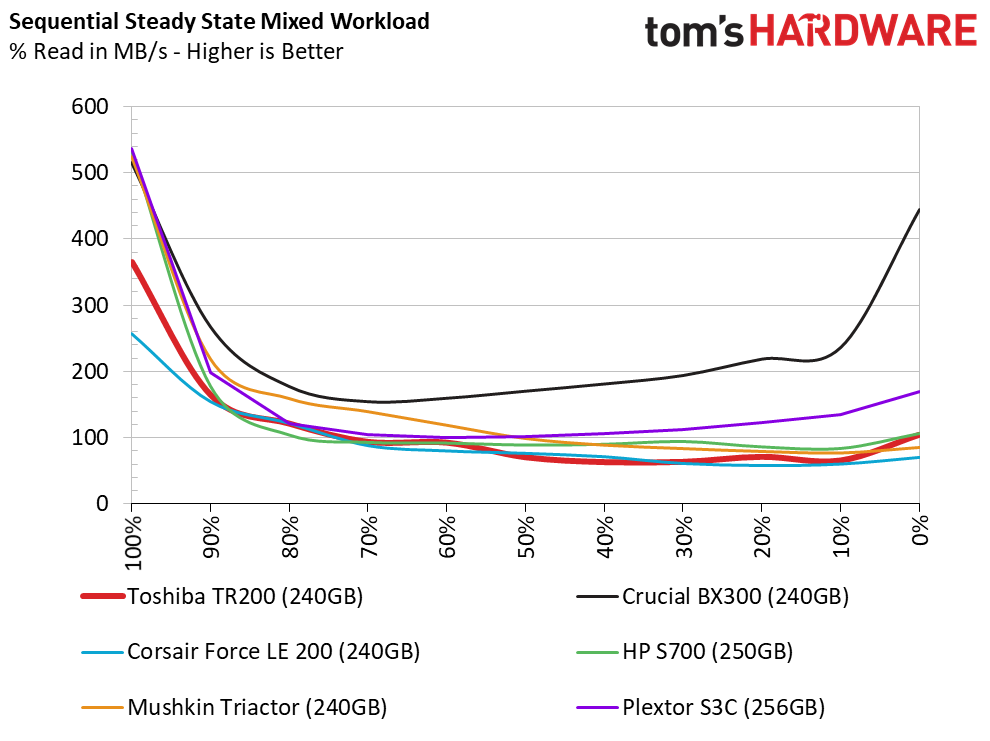
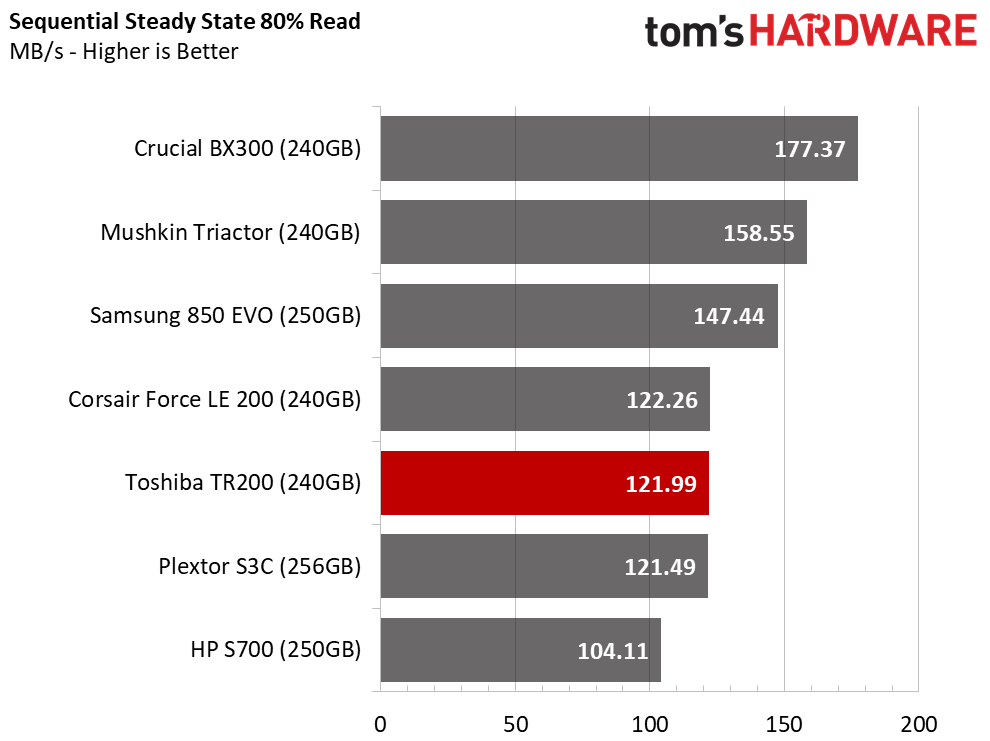
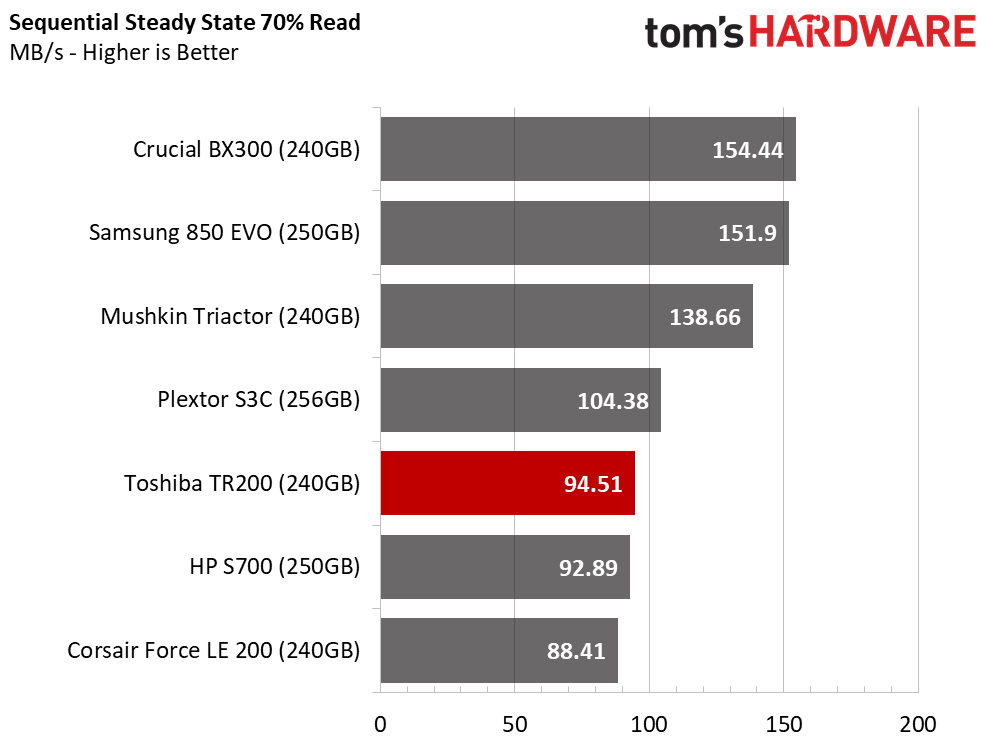
All of the products in the 256GB-class utilize 3-bit per cell (TLC) NAND, except the new Crucial BX300 with 3D 2-bit per cell (MLC) flash. The sequential steady-state test shows how the underutilized MLC still manages to keep performance high when the drives are nearly full. The TLC-powered SSDs continue to struggle.
Random Steady-State
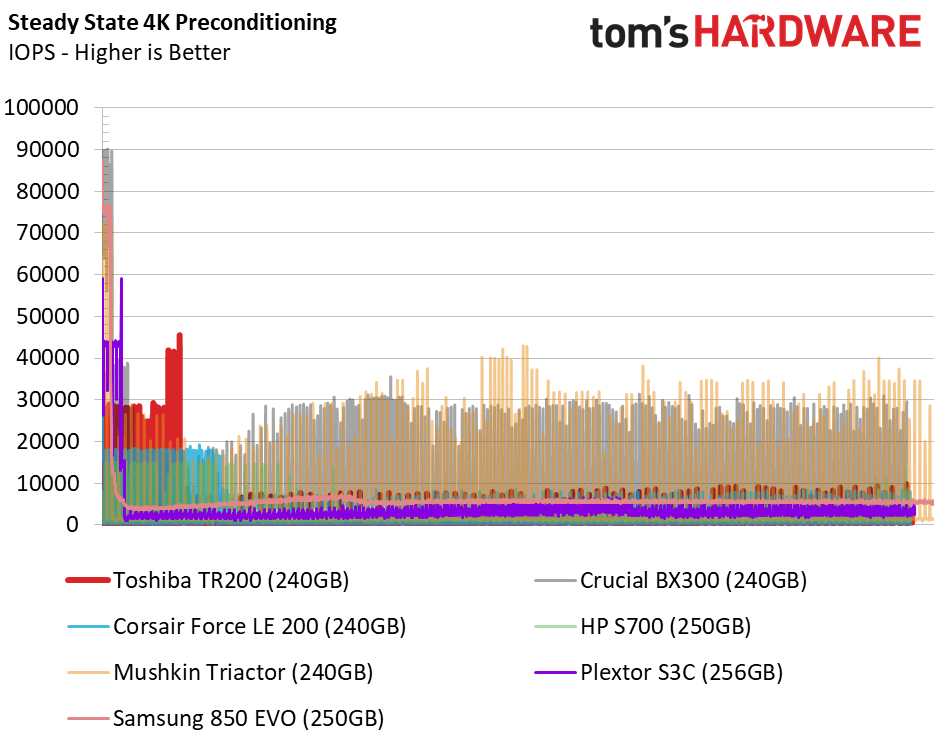
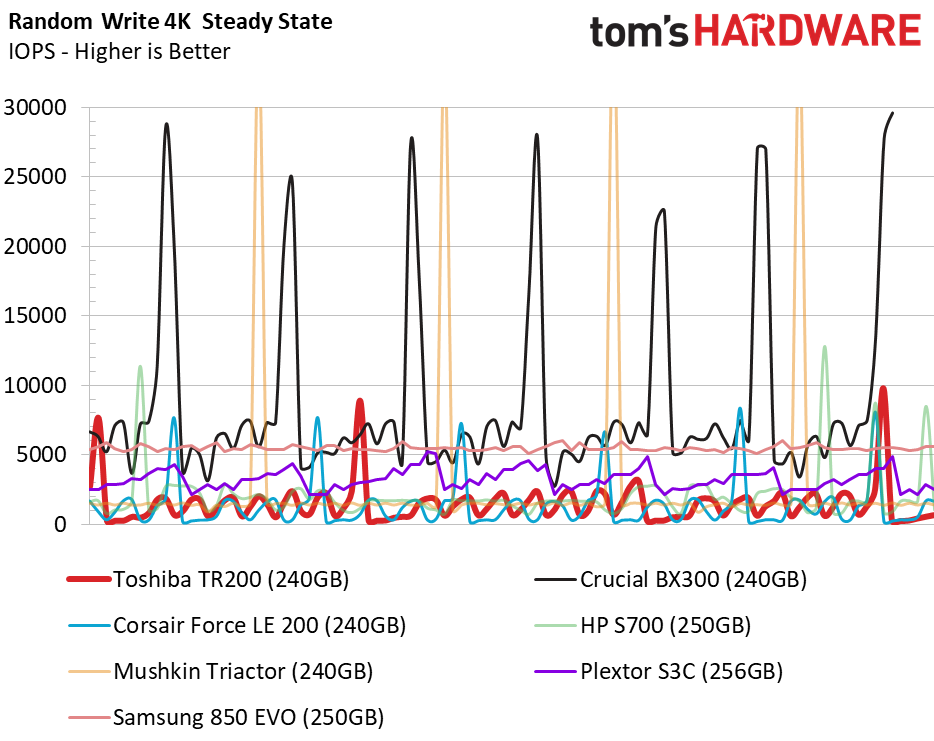
It's odd to see the smallest TR200 achieving higher random performance under steady-state conditions. DRAMless SSDs challenge many of the general performance lessons we've learned about traditional SSDs.
PCMark 8 Real-World Software Performance
For details on our real-world software performance testing, please click here.
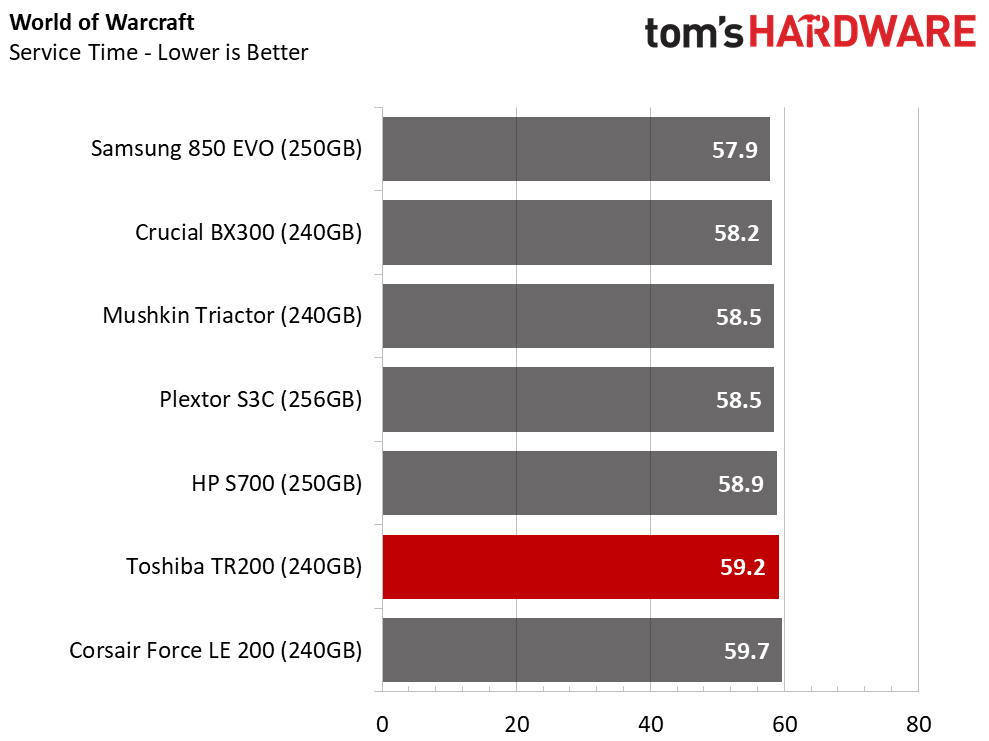
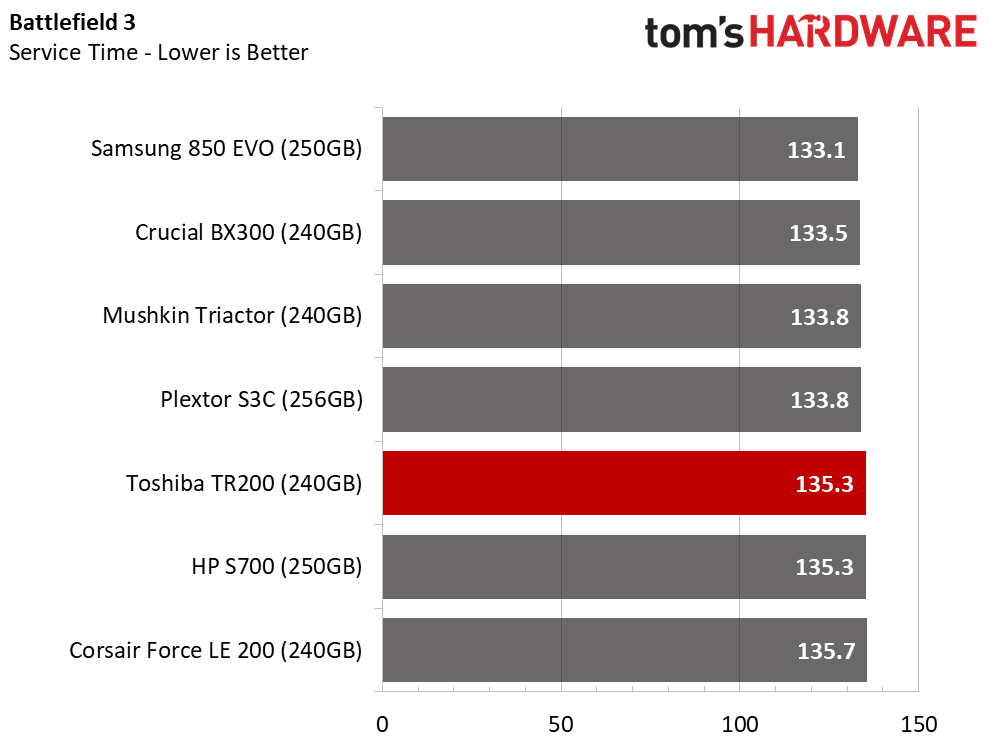
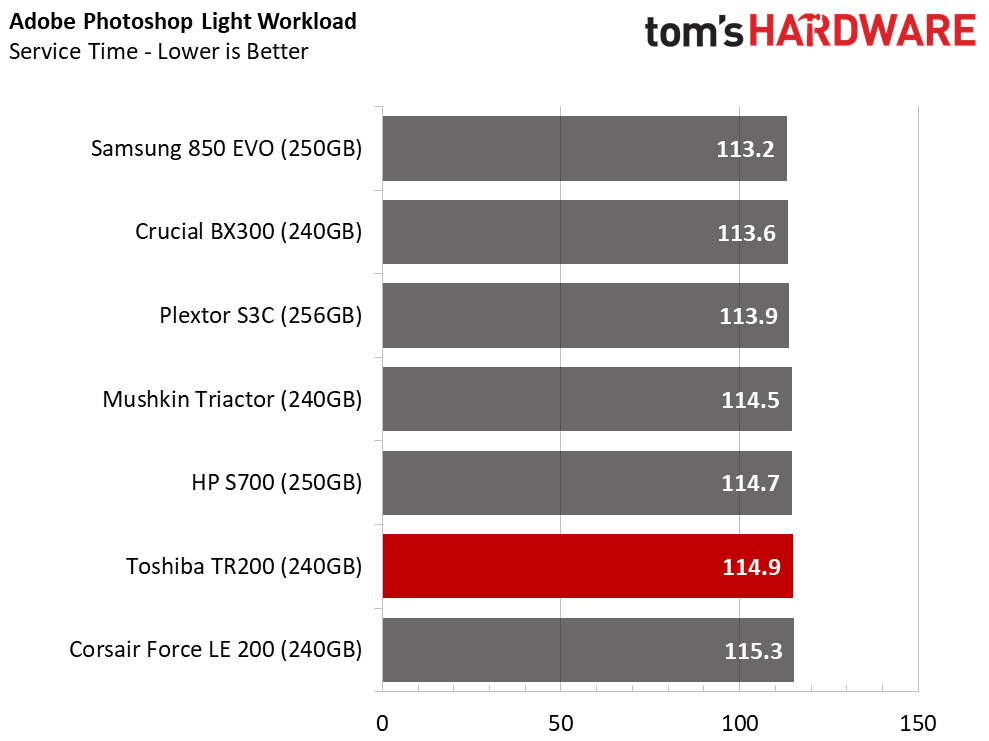
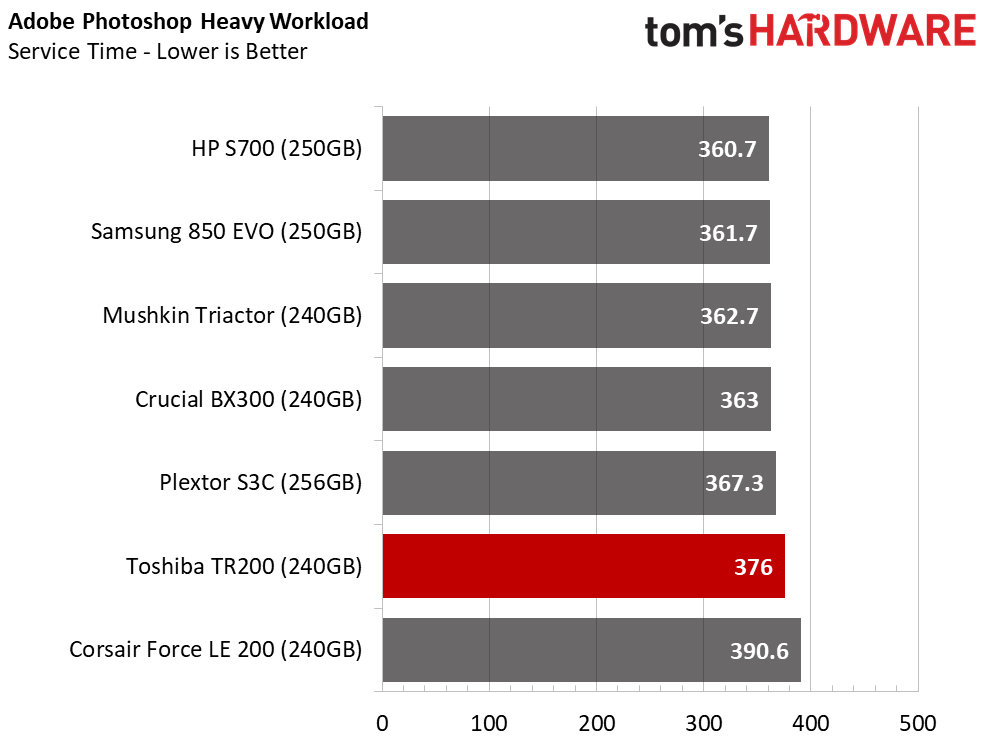
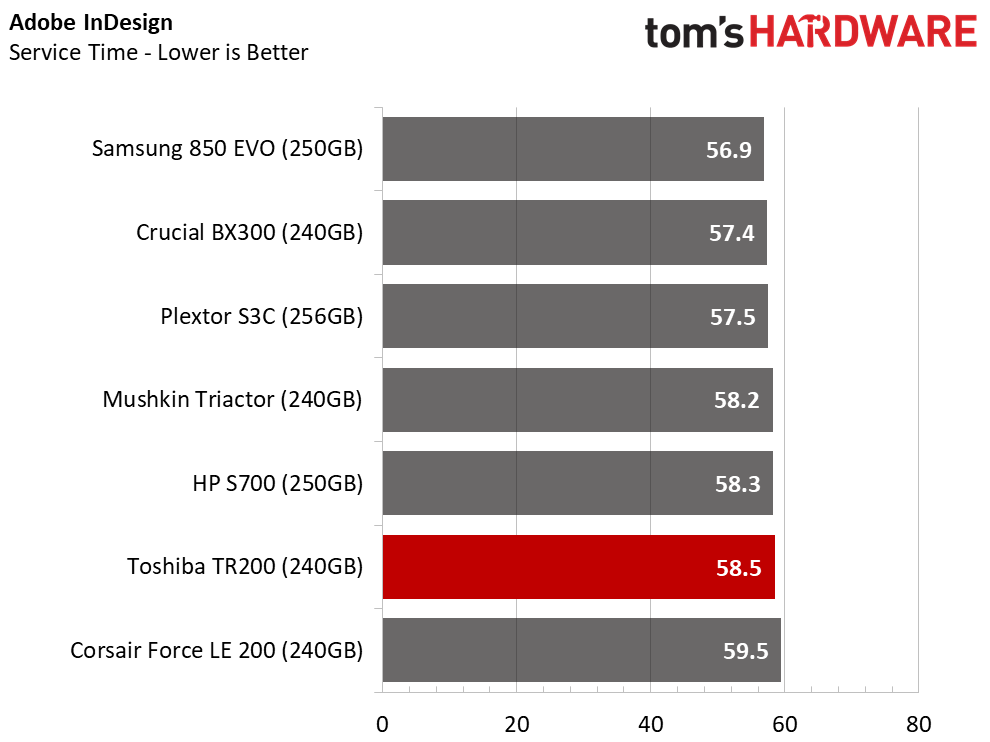
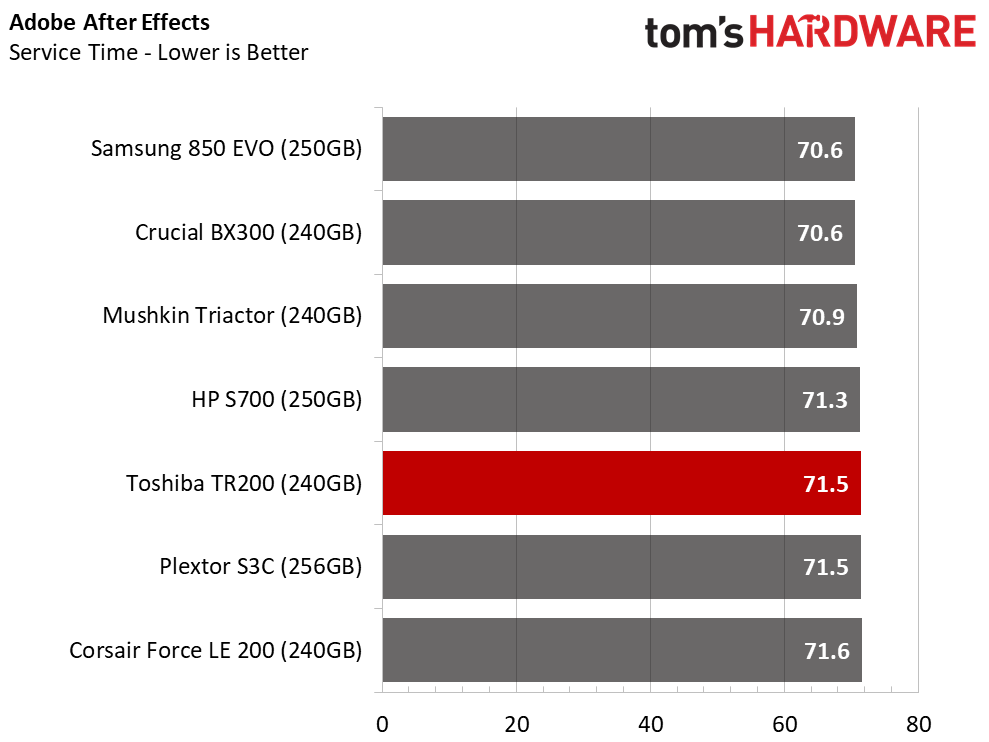
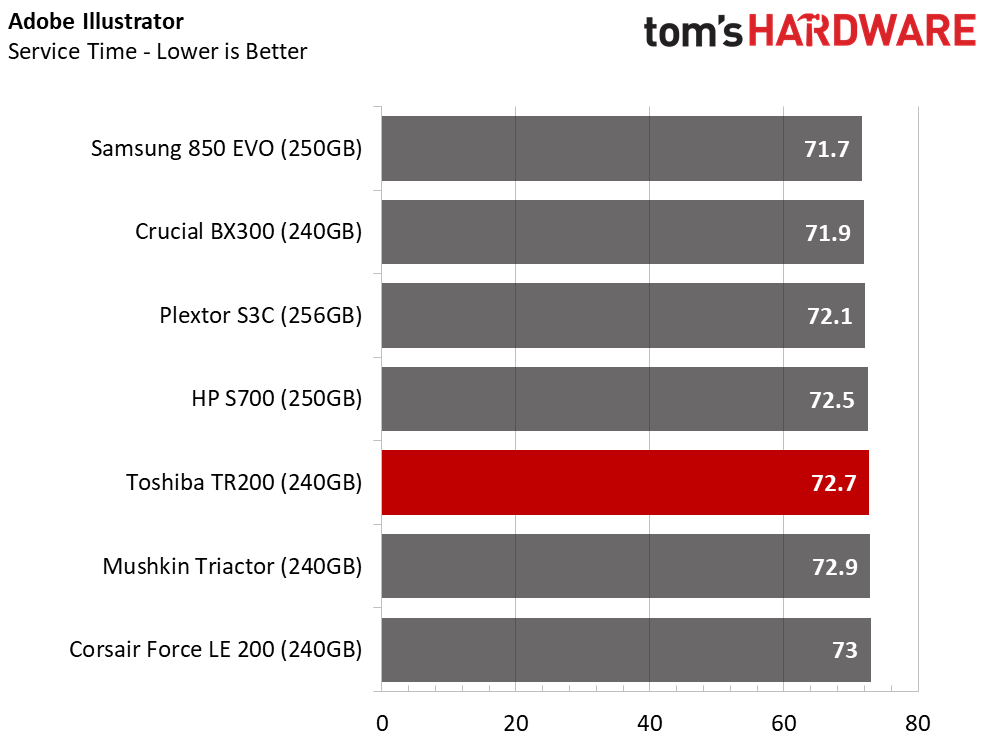
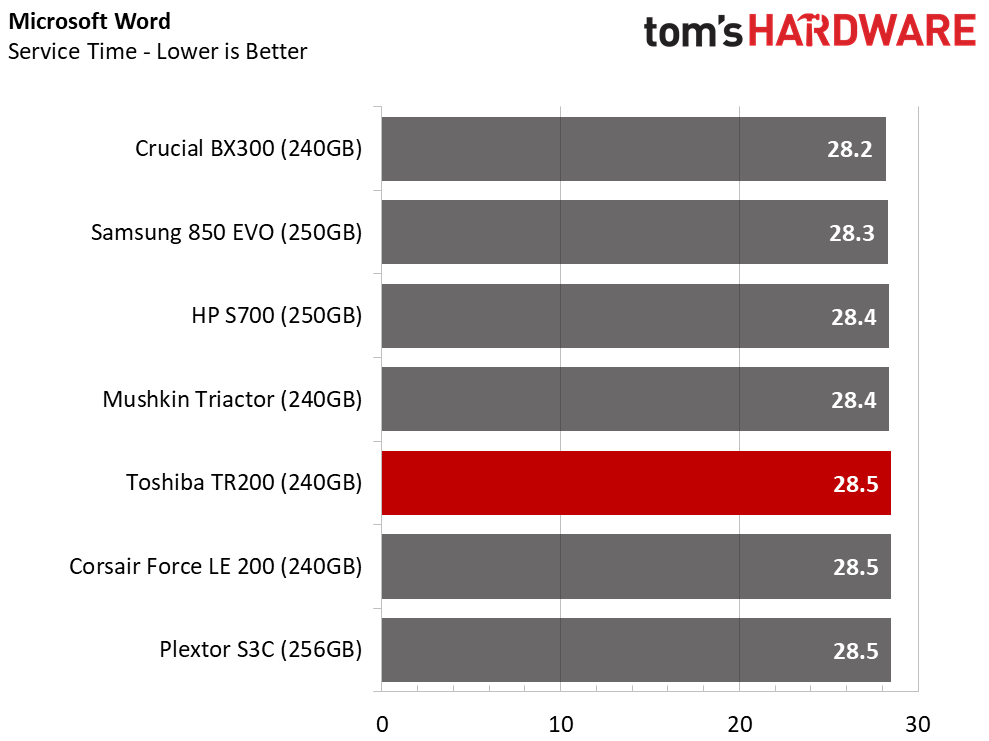

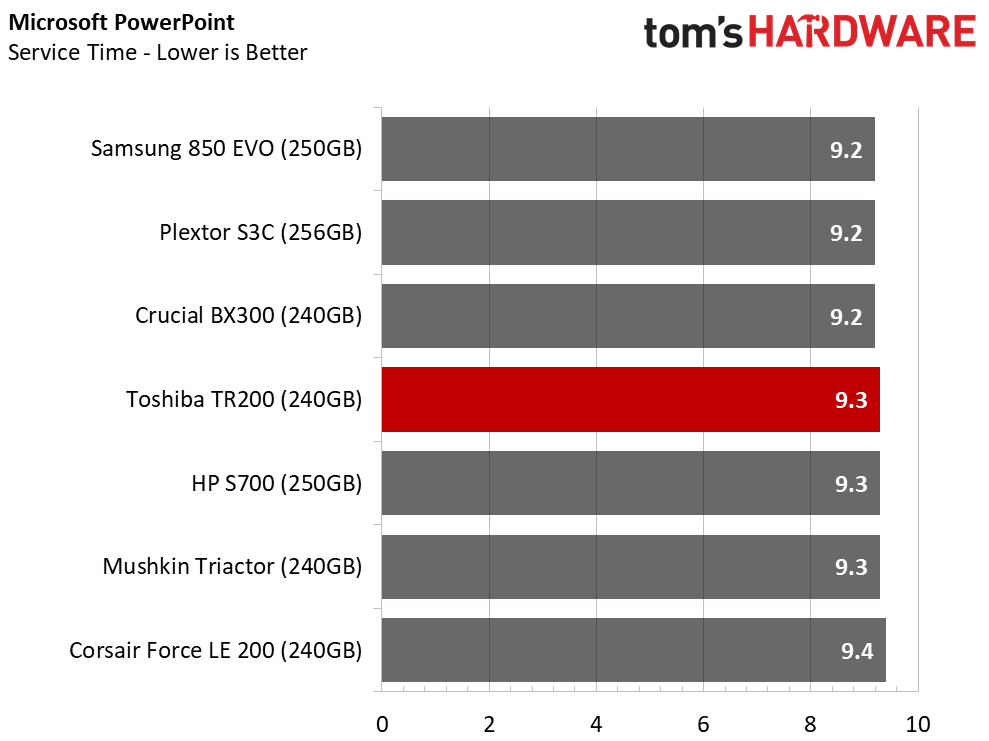
The TR200 is in the mix, but it still lags behind many of the go-to products in this capacity. Most light-use computer users will not compare performance between two SSDs simply because they are migrating from a hard disk drive to an exponentially faster SSD.
Application Storage Bandwidth
The TR200 240GB is less than 20 MB/s faster than the Force LE 200 240GB. This is certainly disappointing, if not damaging, to the DRAMless category as a whole. It really makes us question this category going forward.
PCMark 8 Advanced Workload Performance
To learn how we test advanced workload performance, please click here.
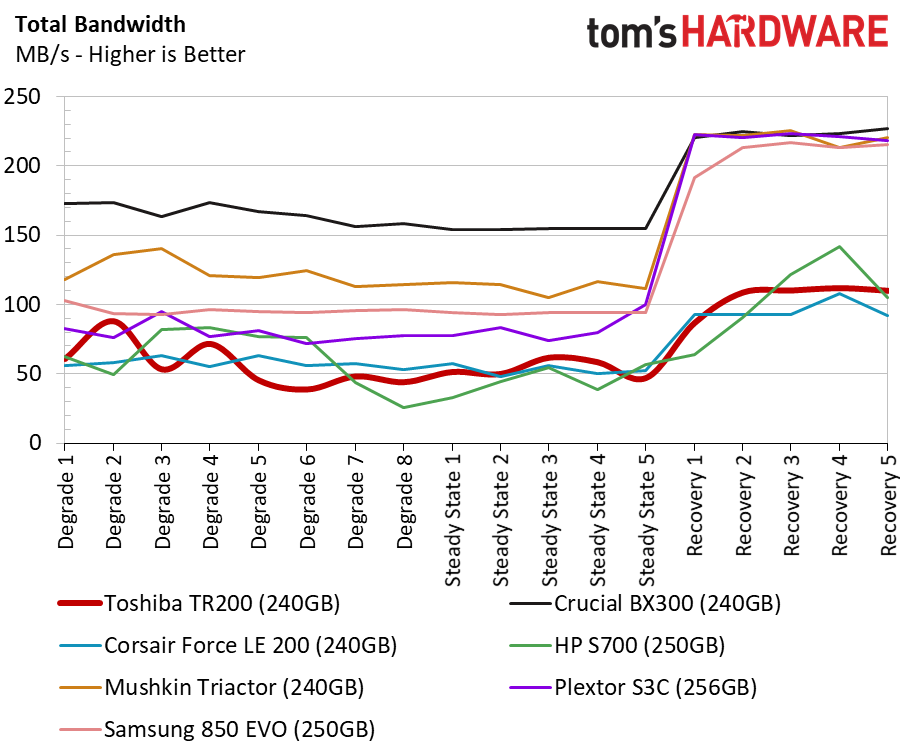
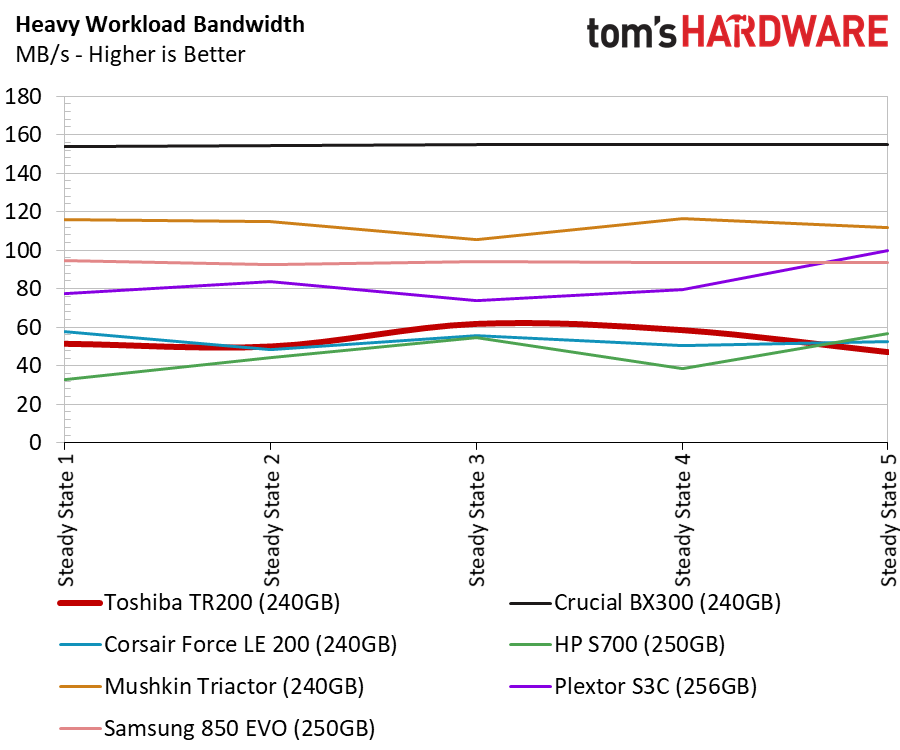

We have other DRAMless products in the comparison charts, so we can move our criticism away from the TR200 and instead focus on the DRAMless products in general. All three of the DRAMless SSDs we have in the charts suffer a severe performance penalty compared to the DRAM products. That would be acceptable if the pricing were in line with the performance.
Total Service Time
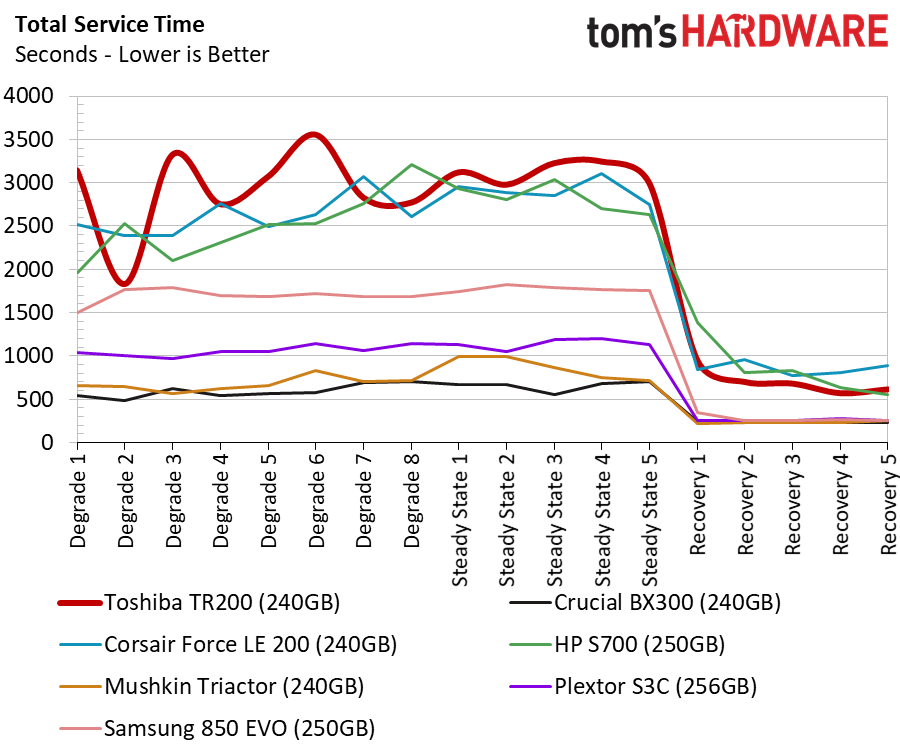
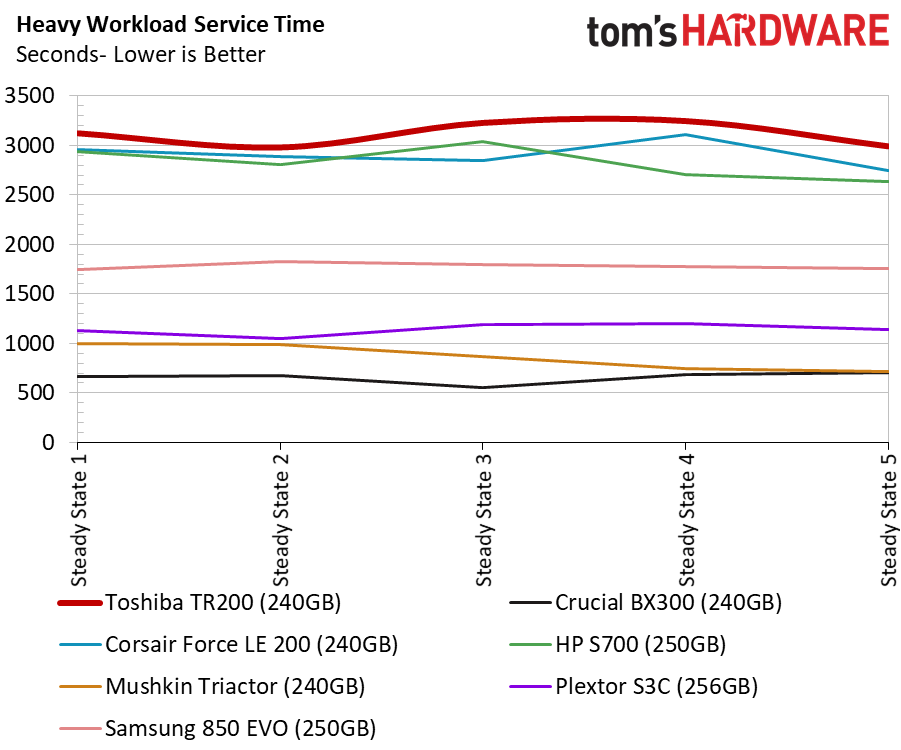
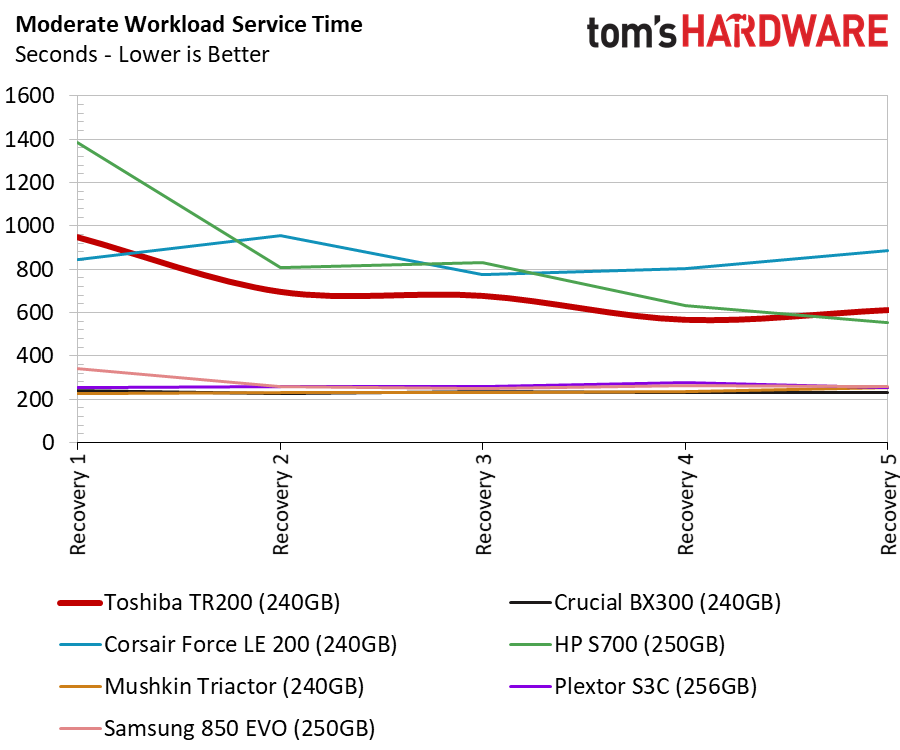
The DRAMless SSDs also cluster together in the service time test.
Disk Busy Time
The DRAMless products continue to exhibit poor behavior during this test.
Responsiveness Test
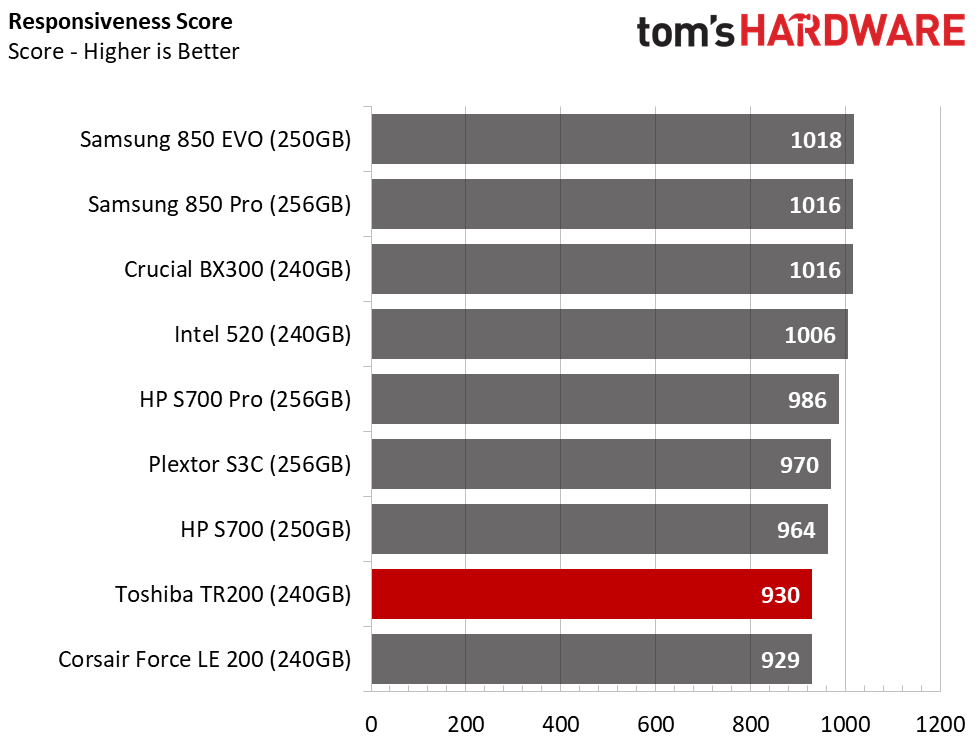
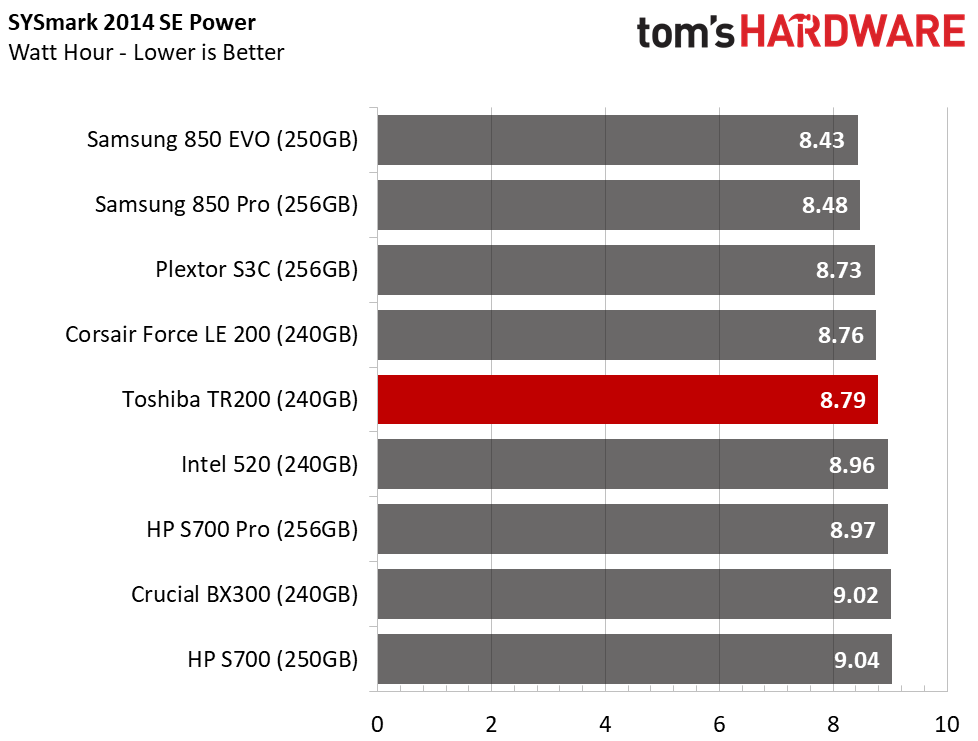
There was a hope that the smaller TR200 with a smaller address map would provide more performance than the larger models, but we didn't see that in many of our tests. The overall user experience is very similar to the Corsair Force LE 200 with Toshiba's older 15nm planar NAND, which is even more disturbing. There is virtually no difference in real-world use.
Notebook Battery Life
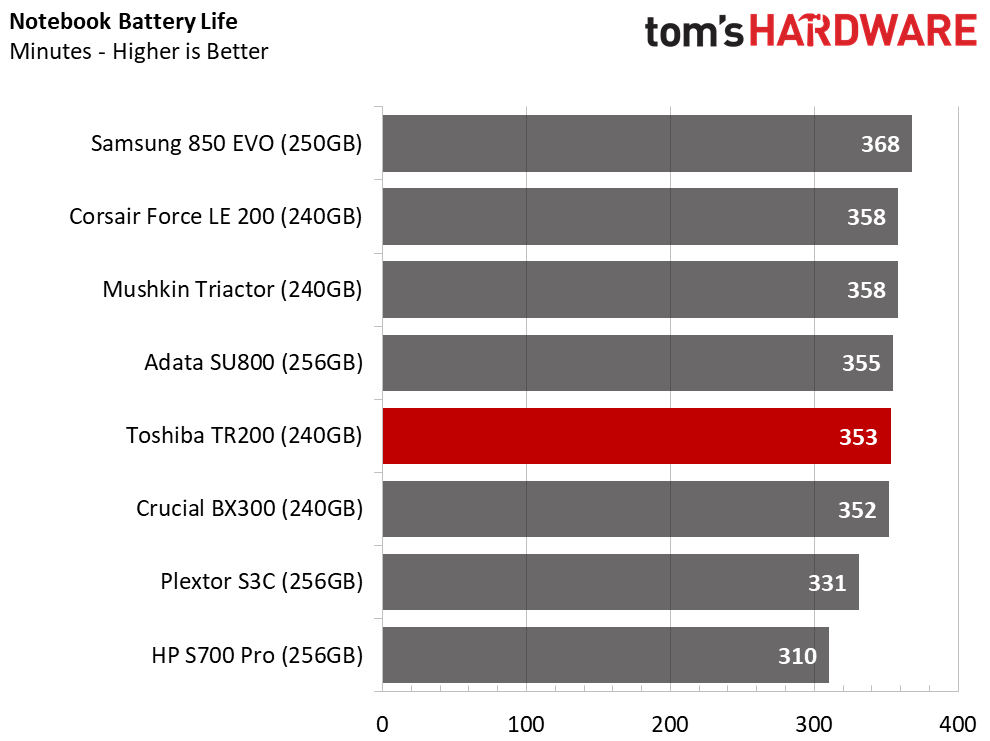
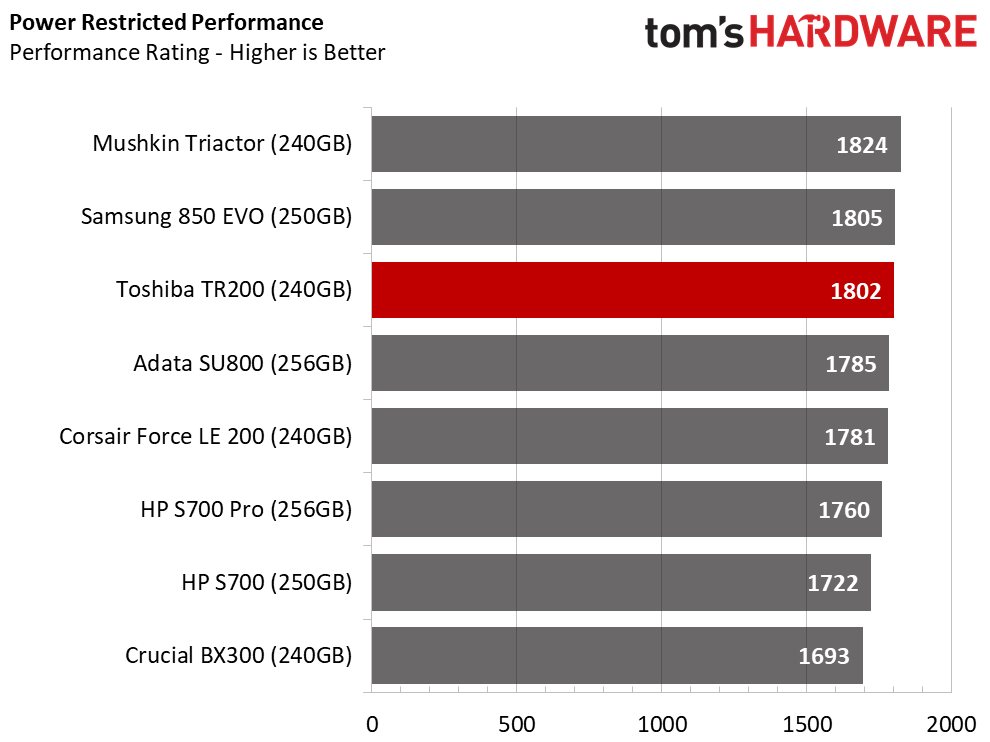
We discovered mainstream battery life results with the 240GB model of the T200. The drive doesn't deliver a significant battery life increase compared to DRAM products, and the drive that it should easily outperform with a 15nm DRAMless configuration is actually slightly better.
MORE: Best SSDs
MORE: How We Test HDDs And SSDs
MORE: All SSD Content

Chris Ramseyer was a senior contributing editor for Tom's Hardware. He tested and reviewed consumer storage.
-
Sakkura Why do they even bother releasing this as a retail product. Just work with the manufacturers of laptops and prebuilt desktops, who are only looking for a cheap way to put "SSD" on their spec sheet and don't care about performance.Reply -
Flying-Q ReplyWe don't think the 240GB and 480GB are not worthy of consideration at launch pricing.
Can you sort out the double negative please? -
AgentLozen It drives me crazy thinking that companies like Toshiba are filled to the brim with talented engineers and yet they still think the best route forward is with a DRAMless design. Are you telling me that not a single high level person compared their SSDs to the competition and said "These things are garbage. Let's stop wasting our money developing them."Reply
Sakkura suggested that these SSDs are meant to be put into prebuilt desktops as a cheap means of adding an SSD to the spec sheet. In the conclusion, the author states that "The results do not justify the means, even with a $10 decrease in component expense. The only price that users care about is what they pay, and DRAMless SSDs are not cheaper than products already on the market." NOBODY benefits from DRAMless SSDs even in a $450 prebuilt desktop.
The situation is frustrating to me because I would rather have big companies like Toshiba not waste their effort designing this crap. I enjoy reading about disruptive new products that shake up the market. I want to experience the Back to the Future 2 utopian future. Products like this take us backwards to a dystopia where the world is ruled by tremendous idiots and as of 2017 we STILL don't have flying cars. -
2Be_or_Not2Be I really dislike DRAM-less controllers. Put this terribly-performing Trash-200 drive on the same level as the Intel 600p - that is, things not to buy!Reply -
gjbaker003 In the "Pricing & Warranty" section it suggests that the $89.99 SSD is 120GB, but the rest of the article states that the $89.99 SSD is 240GB. I would assume at that price point, that 240GB is the correct size of the drive?Reply -
mapesdhs (non-zero origin in the sequential read graph again)Reply
I bet if they were included, the 840 Pro, Vector, Vertex 4 and Neutron GTX from five years ago would still be better than these new Toshiba models. I long for the day when something as good as the 850 EVO is available at a price the 850 EVO was 2 years ago (250GB for 53 UKP, 500GB for 113 UKP).
Whatever happened to SanDisk's promise to release 8TB SSDs for the consumer market by now? -
derekullo Some one lied to Toshiba marketing.Reply
The drive barely hits 300 megabytes a second with that wavy pattern.
It almost looks like the drive was thermal throttling with that pattern. -
HERETIC-1 So sad-with Toshiba 3D available was thinking the "Race to the bottom"Reply
was finally over.
A few dollars worth of Ram could have possibly made these a decent SSD.
Thro the controller could also be part of the poor performance........... -
kookykrazee I will consider SATA technology outdated when I can get 6-10TB drives that are reasonably priced. That will not happen for awhile, so when I got a free $200 BB gift card I got a 8TB drive for $179. This replaced 3 1.5-3TB drives. Gained a few degrees in my case, too :)Reply
